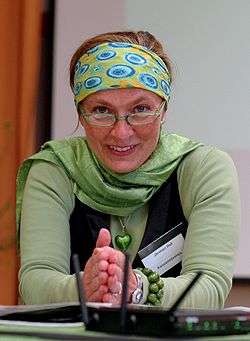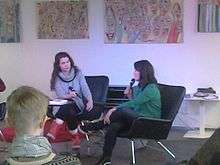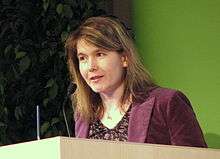Green League
Green League | |
|---|---|
 | |
| Finnish name | Vihreä liitto |
| Swedish name | Gröna förbundet |
| Leader | Ville Niinistö |
| Founded | 28 February 1987 |
| Headquarters |
Fredrikinkatu 33 A, 2nd floor FI-00120 HELSINKI |
| Membership (2013) | 8,034[1] |
| Ideology |
Green politics Social liberalism Pro-Europeanism |
| Political position | Centre-left[2][3] |
| European affiliation | European Green Party |
| International affiliation | Global Greens |
| European Parliament group | The Greens–European Free Alliance |
| Colours | Green |
| Parliament |
15 / 200 |
| European Parliament |
1 / 13 |
| Municipalities |
323 / 9,674 |
| Website | |
| http://www.vihreat.fi/ | |
| Part of a series on |
| Green politics |
|---|
.svg.png) |
|
Core topics |
|
Four Pillars |
|
The Green League (Finnish: Vihreä liitto, Vihr.; Swedish: Gröna Förbundet) is a green[4][5] and green-liberal political party in Finland. It has fifteen seats in the Finnish Parliament and one in the European Parliament. The current chairperson is Ville Niinistö.
Founded in 1987, the party absorbed a number of green organisations, including four MPs elected in 1987. The party won ten seats in the 1991 election. Despite falling to nine seats in 1995, Pekka Haavisto, joined Paavo Lipponen's rainbow coalition first cabinet, making the Green League the first Green party in a national cabinet. The party remained in government until 2002, when it left in opposition to nuclear power. In 2007, the party peaked at 15 seats, and joined the centre-right-led government. At the 2011 election, the party fell to ten seats. Nevertheless, the Greens were invited to join a six-party rainbow coalition government.
The party sits in the centre of the political spectrum, criticising both socialism and the free market. The party is a member of the Global Greens and the European Green Party, while its MEP sit with The Greens–European Free Alliance in the European Parliament. Originally split on whether Finland should join the European Union, the Green League is pro-European and was the first Finnish party to support a federal Europe.[6]
History
The party was founded February 28, 1987, and registered as a political party the next year. Political activity had begun already in the early 1980s, when environmental activists, feminists, disillusioned young politicians from the marginalized Liberal People's Party and other active groups began to campaign on Green issues in Finland. In 1995 it was the first European Green party to be part of a state-level Cabinet.
The party was founded as a popular movement, and thus retains the descriptor liitto, "league". Initially, there was much resistance within the movement against the founding of a political party, motivated by Robert Michels' iron law of oligarchy, which claims that movements inevitably degenerate into oligarchies when they create a formal organization.[7] The party still especially stresses openness and democratic decision-making. The liitto was later dropped from the Finnish and Swedish names in advertisements; the official name remains.
The first two parliamentary representatives were elected even before the registration, in the elections of 1983. These were the first independent representatives in the Finnish parliament. In 1987 the number of seats rose to four, and in 1991 to ten.
About half of Green were against joining the European Union in 1994. Later, polls showed that most Greens were anti-Eurozone.[8] The party heads declined to fight against euro adoption.
In the 1995 election the Green League received a total of nine seats (out of 200), joined the coalition-cabinet led by the Social Democrats, and Pekka Haavisto became the minister of Environment and Development Aid, thus becoming the first green minister in Europe. The Green League received 7.3% of the vote, and gained two additional seats in 1999, raising the total to 11. The Greens continued in the next coalition-cabinet, but resigned in protest on May 26, 2002, after the cabinet's decision to allow the construction of a new nuclear plant was accepted in the parliament. In 2003 the Green League received 8.0% of the vote, giving a total of 14 seats. They increased their seats to 15 in 2007 elections when they received 8.5%. In the 2011 election, however, the party lost five seats.
As of the 2009 elections, two of the thirteen Finnish representatives in the European Parliament are Green: Satu Hassi and Heidi Hautala.
At the municipal level, Greens are an important factor in the largest cities of Finland. In the municipal election of 2008 the Greens had 8.9% of the vote; the vote share was considerably higher in Helsinki (the capital), where the Greens became were the second largest party with 23.2% of the vote.[9] In several other cities the Greens achieved the position of the third largest party. Its weak spot is the rural countryside, particularly municipalities experiencing strong outward migration.
A 2012 study indicated that the Greens have an especially strong support among journalists, among whom they are the most popular party.[10]
The Federation of Green Youth and Students is the Green League's youth organisation.
Ideology and policies
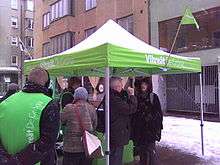
Vihreät is no longer a protest party, nor an alternative movement. Some Green candidates in the elections reject classification as "left" or "right". Economic opinions of the members range between left and right.[7] However, on average members of party place their party between the Left Alliance and Social Democrats.[11] In comparison with some other European green parties, the Finnish Greens are noticeably more pro-European and centrist, has least linked with communists past, compare with the Social Democrats and Leftists.
In the chamber of the Parliament and assembly rooms of local councils, Green League representatives sit between the Finns and the Social Democrats. The Greens often identify themselves as social liberals. The party is one of the strongest proponents for same-sex marriage. The party is also distinct in its opposition against universal male conscription and wants to opt for a gender-neutral, selective version. The eventual goal of the Greens is voluntary military service.
The party's latest policy platform on immigration has called for immigrants must study Finland's official languages, Finnish or Swedish, or lose social welfare benefits. Green Party chair and Labour Minister Anni Sinnemäki states it is an immigrant's duty to learn the language of their new home country.[12]
In 2015, the party included the universal basic income as a major proposal in their platform.[13]
Elections results
Parliament elections

| Election year | # of overall votes | % of overall vote | # of overall seats won | +/- | Notes |
|---|---|---|---|---|---|
| 1983 | 43,754 | 1.47 | 2 / 200 |
||
| 1987 | 115,988 | 4.03 | 4 / 200 |
|
|
| 1991 | 185,894 | 6.82 | 10 / 200 |
|
|
| 1995 | 181,198 | 6.52 | 9 / 200 |
|
|
| 1999 | 194,846 | 7.27 | 11 / 200 |
|
|
| 2003 | 223,846 | 8.01 | 14 / 200 |
|
|
| 2007 | 234,429 | 8.46 | 15 / 200 |
|
|
| 2011 | 213,172 | 7.25 | 10 / 200 |
|
|
| 2015 | 253,102 | 8.53 | 15 / 200 |
|
Local council elections
| Year | Councillors | Votes | Share of votes |
|---|---|---|---|
| 1984 | 101 | 76441 | 2.8% |
| 1988 | 94 | 61581 | 2.34% |
| 1992 | 343 | 184787 | 6.9% |
| 1996 | 292 | 149334 | 6.3% |
| 2000 | 338 | 171707 | 7.7% |
| 2004 | 313 | 175933 | 7.4% |
| 2008 | 370 | 228277 | 8.9% |
| 2012 | 323 | 213100 | 8.5% |
European Parliament
| Election year | # of overall votes | % of overall vote | # of overall seats won | +/- | Notes |
|---|---|---|---|---|---|
| 1996 | 170,670 | 7.6 | 1 / 16 |
||
| 1999 | 166,786 | 13.4 | 2 / 16 |
|
|
| 2004 | 172,844 | 10.4 | 1 / 14 |
|
|
| 2009 | 206,439 | 12.4 | 2 / 13 |
|
|
| 2014 | 160,967 | 9.3 | 1 / 13 |
|
Presidential elections
Parliamentarian and then former MEP Heidi Hautala was a candidate in the presidential elections in 2000 and 2006, taking approximately a 3,5% share of votes in the first round. Pekka Haavisto was the first Green candidate in the 2012 election to enter the second round. Haavisto got an 18,8% share of votes in the first round, and lost to Centre-right Sauli Niinistö in the second round held on 5 February.
| Election year | Candidate | 1st round | 2nd round | ||
|---|---|---|---|---|---|
| # of overall votes | % of overall vote | # of overall votes | % of overall vote | ||
| 2000 | Heidi Hautala | 100,740 | 3.3 (#5) | ||
| 2006 | Heidi Hautala | 105,248 | 3.5 (#4) | ||
| 2012 | Pekka Haavisto | 574,275 | 18.8 (#2) | 1,077,425 | 37.4 (#2) |
Politicians
List of party chairs
-

Kalle Könkkölä
(1987) -

Heidi Hautala
(1987–1991) -

Pekka Sauri
(1991–1993) -

Pekka Haavisto
(1993–1995) -
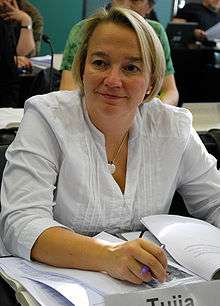
Tuija Brax
(1995–1997) -

Satu Hassi
(1997–2001) -
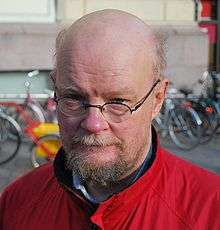
Osmo Soininvaara
(2001–2005) -

Tarja Cronberg
(2005–2009) -
Anni Sinnemäki
(2009–2011) -

Ville Niinistö
(2011–)
Current members of parliament
The following 15 Green politicians were elected to the Finnish Parliament in the April 2015 parliamentary election.[14]
Current members of the European parliament
Since 2014 the Green league is represented with 1 MEP in the European parliament:
See also
References
- ↑ STT (2011-02-07). "Vihreiden jäsenmäärä kasvanut räjähdysmäisesti - HS.fi - Politiikka" (in Finnish). HS.fi. Retrieved 2013-12-23.
- ↑ Lane, Jan-Erik; Svante Ersson (2008). "The Nordic Countries". In Colomer, Josep Maria. Comparative European politics. Taylor & Francis. p. 260. ISBN 978-0-415-43755-4.
- ↑ Josep M. Colomer (25 July 2008). Political Institutions in Europe. Routledge. pp. 260–. ISBN 978-1-134-07354-2.
- ↑ Daniele Caramani (29 March 2004). The Nationalization of Politics: The Formation of National Electorates and Party Systems in Western Europe. Cambridge University Press. pp. 303–. ISBN 978-0-521-53520-5.
- ↑ Claire Annesley (11 January 2013). Political and Economic Dictionary of Western Europe. Routledge. pp. 177–. ISBN 978-1-135-35547-0.
- ↑ Raunio, Tapio; Tiilikainen, Teija (2003). Finland in the European Union. London: Routledge. p. 52. ISBN 978-0-7146-5375-4.
- 1 2 Rauli Mickelsson. Suomen puolueet - Historia, muutos ja nykypäivä. Vastapaino 2007, 429 pages.
- ↑ "4.2 Suomi Euroopan Unionissa".
- ↑ "Vaalit 2008 tulospalvelu - Helsinki - Puolueiden kannatus" (in Finnish). Yle.fi. 2008-10-30. Retrieved 2013-12-23.
- ↑ "Aamulehti" (in Finnish). Aamulehti.fi. Retrieved 2013-12-23.
- ↑ Elo, Kimmo – Rapeli, Lauri (2008): Suomalaisten politiikkatietämys. Oikeusministeriön julkaisuja 2008:6.
- ↑ "Greens to Immigrants: Learn Finnish or Lose Benefits". YLE. 11-10-2010. Retrieved 11-10-2010. Check date values in:
|access-date=, |date=(help) - ↑ "Vihreät haluaa 560 euron perustulon kaikille". Kaleva.fi. Retrieved 24 February 2015.
- ↑ "Eduskuntavaalit 2015". Yle. Retrieved 22 April 2015.
External links
- Official site (Finnish)


